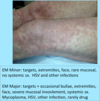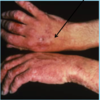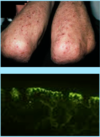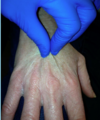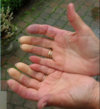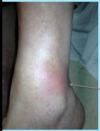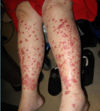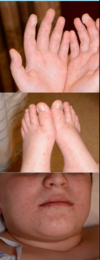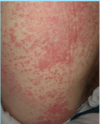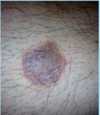Dermatopathology Flashcards
A: Identify
B: What are the 2 types of Biopsy

B: Punch (shown in image) vs. Shave

A: Identify
B: What is the Epidermis composed of (4)
C: Define Hyperkeratosis
D: Define Parakeratosis
E: What connects [Basal Layer] to Dermis (2)

Cancel Lab, Get Some Beer

B: MLK belongs in the Epidermis - [Melanocytes & Merkels Disc] / Langerhan / Keratinocytes]
C: When [Stratum Corneum] becomes thick
D: When [Straum Corneum] retains Nuclei
E: Hemidesmosomes & [Undulated Projections from Rete Ridge]
A: How long does [Epidermal maturation] from basal cell to [cornified cell] take
B: What’s the result of [Disordered maturation]
C: What condition shortens this maturation
A: 25 Days = [Desquamatization Vertical Maturation]
B: Skin thickening due to No Desquamation
C: Inflammation
A: Define Ichythosis
B: What’s the most common subtype and its [Mode of Inheritance]
C: Name the other 3 subtypes
A: Hereditary DO that appears at birth = Defective Desquamatization –> build up of compacted scales
B: Ichthyosis Vulgaris (AD vs. acquired)
C:
- [Congenital Ichthyosiform Erythroderma (AR)]
- [Lamellar Ichthyosis (AR)]
- [X-linked Ichthyosis–> Defective steroid sulfatase]
A: Describe the Histology (2)
B: Dz

Ichthyosis Vulgaris
Orthokeratosis = Thickening of Stratum Corneum = Hyperkeratosis without Parakerotosis

A: Describe Histology
B: Dz

Ichthyosis Vulgaris

A: Describe Histology
B: Dz
C: Location
D: Demographic

A: Stuck-on,” waxy appearing brown papules or plaques
B: Seborrheic Keratosis
C: Anywhere on Skin [except palms/soles]
D: Pt > 30 y/o

A: Describe Histology (5)
B: Dz
C: Location
D: Demographic

A:
- [Hyperkeratosis (light purple in top L)]
- Epidermal Acanthosis made of uniform small keratinocytes
- Horn Cyst
- [Flat Base String Sign] = no infiltration into dermis
- [Papillated Undulated Epithelium] (Papillomatosis)
B: Seborrheic Keratosis
C: Anywhere on Skin [except palms/soles]
D: Pt > 30 y/o

A: Describe Histology (3)
B: Dz
C: Location (2)
D: What’s this Dz caveat

A: image
B: Acanthosis Nigricans
C: Axilla and Neck Creases
D: THERE IS NO ACANTHOSIS ON HISTOLOGY

A: Describe Histology (3)
B: Dz
C: Location (2)
D: What’s this Dz caveat

A: image
B: Acanthosis Nigricans
C: Axilla and Neck Creases
D: THERE IS NO ACANTHOSIS ON HISTOLOGY

A: Describe the sign associated with [Seborrheic Keratosis]
B: Demographic
Leser Trelat Sign

A: Paraneoplastic Syndrome accompanied with acute onset of multiple SK
B: Pts with metastatic CA
What are the 2 Types of [Acanthosis Nigricans]
- Benign type = childhood (Obesity/Endocrine vs. Hereditary)
- Malignant = middle age and up pts who have other internal malignancies
A: Describe Histology (2)
B: Dz
C: Composition

A: image
B: [STAFP: Skin Tag Achrochordon Fibroepithelial Polyp]
C: [Outgrowth of (Fibroblast/Collagen/Vessels) covered in acanthotic epidermis]

Name 2 common [Epithelial Neoplasms]
[Seborrheic Keratosis] & [Acanthosis Nigricans]
A: [Actinic Keratosis] is a precursor to ______
B: Tx (2)
A: [Actinic Keratosis] is a precursor to [Squamous Cell Carcinoma]
B:
- Cryotherapy
- Topical tx
A: Describe Histology (3)
B: Dz
C: What’s the primary leukocyte in the skin

A: image
-Solar Elastosis=Grayish-bluish color of the Dermis from sun damage
B: [Actinic Keratosis-PreMalignant]
C: Lymphocyte

A: Describe Histology (3)
B: Dz
C: What’s the primary leukocyte in the skin

A: image
-Solar Elastosis=Grayish-bluish color of the Dermis from sun damage
B: [Actinic Keratosis-PreMalignant]
C: Lymphocyte

A: Name the 2nd most common Skin Tumor
B: Risk Factors (11)
C: What’s the BIGGEST Risk Factor and why
A: Squamous Cell Carcinoma
B: HAIR IN WOMBS
- [HRAS activating mutation]
- Arsenic
- Immunosuppresion (HPV)
- Radiation-ionizing
- Industrial
- [Notch receptor LOSS OF FUNCTION mutation]
- Wounds-chronic
- Older
- Males
- Burn Scars
- SUN!!!!! = BIGGEST RISK FACTOR!
C: Sun–>[TP53 mutation at pyrimidine dimers] (INC potential in Xeroderma Pigmentosum pts)

A: Describe Histology (3)
B: Dz

A: image
B: [Squamous Cell Carcinoma]

A: Describe Histology in each image
B: Dz

A: image
B: [Squamous Cell Carcinoma]

A: Describe Histology (3)
B: Dz
C: How would this appear Clinically
D: Tx

A: image
B: [SQC IN SITU] = BOWEN’S DZ
C: Plaque
D: Excision (will not regress on its own-but won’t metastasize once excised)

What is [Bowenoid Papulosis] (3)
Same Histology as [SQC IN SITU Bowen’s Dz] but is
- HPV induced
- Genital location
- Frequent multiple papules
Basal Cell Carcinoma
A: Statistic
B: Risk factors (3)
C: Pathogenesis (2)
A: Most common invasive CA in humans
B:
- [Sun exposed sites of Older pts]
- Immunosuppressed
- [Xeroderma Pigmentosa (DNA mismatch repair syndromes)
C: [PTCH Hedgehog signaling mutation] vs. [P53 mutation]

A: Describe Histology (3)
B: Dz

A: image
B: Basal Cell Carcinoma

A: Describe Histology (3)
B: Dz

A: image
B: Basal Cell Carcinoma

[Nevoid Gorlin Basal Cell Carcinoma Syndrome]
A: Pathogenesis
B: Mode of Inheritance
C: What is this often accompanied with (3)
A: [2 Hit Hypothesis] involving [PTCH Chromo 9 Hedgehog signaling mutation]
B: Auto Dom
C: Medulloblastoma/Ovarian Fibroma/ [Odontogenic Keratocyst]

Name the most common [Melanocytic Neoplasms] (3)
- Lentigos
- Melanocytic Nevi
- Melanoma
A: Name these cells
B: Where are they found
C: What’s their ratio to other cells
D: Function

B: [Basal Layer of Epidermis] (along with Merkel Disk)
C: [1:10 ratio = (1 melanocyte):(10 Basal Keratinocytes)]
D: [Uses Tyrosinase to Produce Melanin]–>worn by [Basal Keratinocytes] to block out UV

A: Function of these cells
B: Pathogenesis of Albinism

A: [Uses Tyrosinase to Produce Melanin]–>worn by [Basal Keratinocytes] to block out UV
B: They Lack Tyrosinase
A: Most common Skin lesion of Childhood
B: Description (2) and Pathogenesis
C: Location
A: [Freckle Ephelis]
B: [Small & (Red - Brown macules)] from INC melanin pigment within basal keratinocytes. Comes from [Enlarged but normal density Melanocytes]
C: Sun exposed areas
Lentigo
A: Clinical Description (2)
B: Location & Demographic
C: Histology
A: Small & [Tan-Brown]
B: Mucus membranes / any age
C: Melanocyte Hyperplasia along basal layer
A: Describe Histology
B: Dz
C: Locations (3)
D: Clinical Description

A: image
B: [IntraDermal Melanocytic Nevus]
C: Common Type = [IntraDermal vs. Junctional vs. Compound]
D: [Tan - brown] Macules vs. Papules

A: Describe Histology (3)
B: Dz

A: image
B: Dysplastic Nevi

A: Clinical Description of [Dysplastic Nevi] (2)
B: Locations (2)
C: Pgn
A:
- [Tan - brown] slightly raised Macules
- [>5 mm]
B: Sun exposed AND Protected Areas
C: Are Clinically stable, which –> Melanoma Risk from DEC early detection

A: Describe [Dysplastic Nevus Syndrome]
B: Genetic Causes (2)
C: Mode of Inheritance
D: Pgn
A: Tendency to develop [Multiple Dysplastic Nevi AND MELANOMA]
B: [CDK-N2A Chromo 9 mutation] vs. [CDK4 Chromo 12 mutation]
C: Auto Dom
D: 50% develop Melanoma by 60!

A: Describe Histology (5)
B: Dz
C: List the Prognostic Factors (4)

A: image
B: Melanoma
C: “Use MUDS to assess Melanoma PGN!”
- [Depth *Breslow* - good indicator especially whenGRTR** than 1 MM thickness]
- [# of Mitotic Figures - only can be used with <1 MM thickness] = always poor pgn if positive
- Ulceration

A: What test is used if [Melanoma is > 0.8 MM]
B: Pgn for Melanoma in general
A: [Sentinel Lymph Node Biopsy]: if positive = Stage 3 = POOR PGN
B: FATAL (early recognition and surgical excision is IMP)
“Use MUDS to assess Melanoma PGN!”

A: Describe Histology
B: Dz

A: image
B: Melanoma

A: Describe Histology
B: Dz

A: image
B: [Melanoma In Situ] (No dermal infiltration)
Melanophages are seen in dermal level and have pigment covering their nucleus

A: Melanoma Risk Factors (4)
B: Which Risk Factor has a tx and what is the tx
“Blacks Circumvent Sun CA”
- Sun Exposure (not straight forward)
- [CDK-N2A Chromo 9 mutations]
- BRAF mutations –> [Tx = Vemurfenib]
- [CKIT mutation in non-sun exposed]

Describe the 2 Growth Phases of the Dz showin in the Image

1st: [Radial Growth Phase] = Lentigo Maligna (lentigenous) superficial spreading
2nd: [Vertical Growth Phase] = Nodular or [Progression of Radial Growth phase]–> Metastatic potential into Dermis with lil epidermal involvement

Describe the 4 Stages of Melanoma
Stage 0 = [Melanoma In Situ]
Stage 1/2 = Confined to Skin = 5 year Survivial
Stage 3 = [Sentinal Lymph node] = 5 year Survival
Stage 4 = [Distant Skin vs. Visceral Metastasis] = 5 year Survival
A: Identify Histology (2)
B: Dz (2)
C: Composition
D: Which Dz makes keratin –> appears as [keratin filled cyst structure]

A: image
B:
L arrow = [Fibroepithelial Polyp]
R arrow = [EpiDermalInclusion Cyst Wen] - [DERMAL BASEDnodule made of [Infundibular hair follicle tht hasloss its rete pegs]. Also makes Keratin–> Appears as [Keratin filled cyst structure] lined with epidermis. Does NOT communicate with epidermis

A: Describe Histology (2)
B: Dz
C: Composition

A: image
B: [EpiDermal Inclusion Cyst Wen]
C: [DERMAL BASED nodule made of [Infundibular hair follicle but tht has loss its rete pegs]. Also makes Keratin–> Appears as [Keratin filled cyst structure] lined with epidermis. Does NOT communicate with epidermis

A: Describe Histology
B: Dz and composition
C: Explain the Precipitating Dz of this, its [mode of inheritance], and pathogenesis

A: image
B: Trichilemmoma - [outer root sheath proliferation] with epidermal vertical growth
C: Cowden’s Dz (Auto DOM): [PTEN mutation] –> [Multiple Trichilemmoma] / [Breast-Endometrial-Thyroid CA] / Fibromas

A: Describe Histology
B: Dz
C: Location

A: image
B: DermatoFibroma
C: LE

A: Describe Histology (2)
B: Dz
C: Location

A: image
B: DermatoFibroma
C: LE

A: Describe Histology (2)
B: Dz
C: Location
D: Pgn

A: image
B: [DFSP - DermatofibroSarcoma Protuberans]
C: image
D: Aggressive local invasiveness –> morbidity
- CD34 Positive*
- [Dense Dermal Proliferation] / [Fayo/Morbidity from local invasiveness] / [Storiform Cartwheel] / [Protuberans on a large nodule]*

A: Describe Histology (2)
B: Dz
C: Location
D: Pgn

A: image
B: [DFSP - DermatofibroSarcoma Protuberans]
C: image
D: Aggressive local invasiveness –> morbidity
- CD34 Positive*
- [Dense Dermal Proliferation] / [Fayo/Morbidity from local invasiveness] / [Storiform Cartwheel] / [Protuberans on a large nodule]*

A: Describe Histology
B: Dz
C: Cause

A: image
B: Keloid
C: Hyperrxn after Trauma

A: Identify Dz
B: What syndrome is this associated with? Describe the Syndrome (Mode of Inheritance,Pathogenesis)

A: Sebaceous Adenoma
B: [Auto DOM- Muir Torre Syndrome] = [MLH1 vs. MSH2 DNA mismatch repair gene mutation]–> microsatellite instability –>
- Sebaceous Adenoma
- GI CA
- GU CA

A: Describe Histology (3)
B: Dz

A: image
B: Leiomyoma

A: Describe Image (Clinical vs. Histo)
B: Dz
C: Which vessels are affected (2)

A:
- Clinical: [Palpable Purpura +/- LE Ulceration]
- Histo: Inflammation of arteries in subcutis with fibrin deposition
B: [PNEI - Polyarteritis Nodosum Erythema Induratum]
C: Small and [Medium Muscular] arteries

A: Describe Image (Clinical vs. Histo)
B: Dz
C: Location
D: Causes (3)

“[Erythema NoDosum GIFTS]”

A: image
B: Erythema Nodosum
C: Front Of Legs
D:
- Drugs (Sulfa vs. NSAID vs. BCP)
- TB Infection
- Idiopathic
“No Dosum GIFTS”
[Needs space = Macule more spread out Papules] / [Drug-induced] / [Giant cells + Histiocytes]/[Idiopathic]/[Front Legs]/[TB]/[Septal fibrosis & Inflammation]
A: Describe image (5)
B: Dz
C: How does this manifest in the mouth
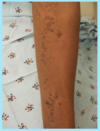
“The Lichens had sawteeth and always had a plan”

A: image
B: Lichen Planus (subtype of Lichenoid Dermatitis)
C: image







